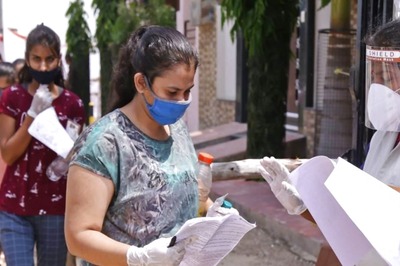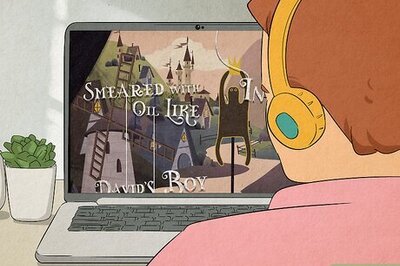
views
Check your connections.
Your monitor may not be connected or plugged in. According to Oppido, if your monitor is not displaying an image, you should check the connections to your computer. Does your monitor have a stand-by light on? Make sure the cables aren't damaged. Try using a different cable. Make sure the cables are connected to the correct port (i.e. the graphics card rather than the on-board display output). If your cable is not working, it will need to be replaced. If there is any dirt or debris in the connectors or ports, you can remove it with compressed air, or you can use a small, dry, soft-bristle brush.
Check if the monitor is working.
Your monitor may be broken or defective. Try connecting your monitor to a different computer or device. See if you are able to get a display on your monitor when connected to a different device. If you are using a laptop, try connecting to an external monitor. If you are not able to get a display when connected to any device, the issue is most likely with your monitor. You may need to replace your monitor. If you can get a display on a different computer, the issue is most likely with your computer.
Check your monitor's settings and light levels.
Your monitor may be dark or on a different source input. Check the brightness settings on your monitor. Make sure it hasn't been turned all the way down. Also check the source input. Make sure it is set to the correct HDMI or DisplayPort input source. The brightness settings settings usually have an icon that resembles a sun. On laptops, it's usually one of the F-keys. The source input button usually has an icon that resembles a rectangle with an arrow. If your monitor has the capability, you can also update your monitor's firmware. If your monitor has the capability, try resetting it to it's factory settings.
Use keyboard shortcuts.
Your computer or graphics driver may not be responding. There are a couple of quick keyboard shortcuts you can use to solve display issues. One will wake your computer if it's not coming out of sleep mode. Another keyboard shortcut will reset your graphics drivers if they are not responding. Use the following keyboard shortcuts to try to resolve the issue: Press ⊞ Win+Ctrl+Alt+Del+P to wake your computer from sleep mode. Press ⊞ Win+Ctrl+⇧ Shift+B to reset your graphics driver.
Restart your computer.
There may be a minor glitch. You can often fix minor glitches by restarting your computer. If you can't navigate to the Power options on your computer, press and hold the Power button on your computer until your computer powers off. Unplug your computer for 30 seconds and plug it back in. Then press the power button again to turn it back on.
Boot your computer into safe mode.
There may be a software issue. Safe mode boots your computer with the minimum startup programs and drivers needed to run your computer. If you are able to get an image on your monitor in Safe Mode, you can use Safe Mode to troubleshoot the problem. If you can't access Windows without a display, you can try booting into Windows via the Windows Recovery Environment (WinRE) Use the following steps to boot into Safe Mode: Shut down your computer. Power your computer on. Immediately press and hold the power button to force it to shut down. Repeat three times to boot into Windows Recovery Environment. Click Troubleshoot. Click Advanced Settings. Click Startup Settings. Click Restart.
Press "5" for Safe Mode with Networking.
Update Windows.
Windows or your drivers may be outdated. Keeping Windows and your drivers up-to-date ensures they are running properly and efficiently. It also helps patch out any bugs or flaws that may be causing display issues. When you update Windows, it generally will update your drivers automatically. If you are able to access Windows temporarily or in Safe Mode, use the following steps to update Windows: Click the Windows Start button. Type Windows Update. Click Windows update settings. Click Check for updates. Click Download & install all.
Update your graphics drivers manually.
Your graphics drivers may be outdated. If updating Windows doesn't fix your display issues, you can try updating your graphics drivers manually. You can update your graphics drivers via the NVIDIA Control Panel or AMD app or by downloading the latest drivers from the manufacturer's website of your graphics card. You can also use the following steps to update your graphics drivers via the Device Manager: Right-click the Windows Start button. Click Device Manager. Expand Display adapters. Right-click your display driver (there may be more than one). Click Update driver. Click Search automatically for drivers. Follow the prompts to install the latest drivers if one is found.
Scan for viruses.
You may have a virus or malware infection. You can scan for viruses using Windows Defender in regular mode or Safe mode. Use the following steps to do so: Click the Windows Start menu. Type "Windows Security." Click Windows Security. Click Virus & threat protection. Click Quick scan or Scan now.
Disconnect all accessories.
Accessories may be interfering with your display. Sometimes external devices can interfere with your computer's operations. Especially during startup. Disconnect any USB devices plugged in. This includes hard drivers, game controllers, mice, keyboards, and VR headsets. See if this fixes the issue.
Rollback your graphics drivers.
A driver update may be causing an issue. In some rare cases, an update to your graphics driver may cause issues with your system. If the issue with your graphics driver started after a Windows update, you may want to try rolling back your graphics drivers. Use the following steps to do so: Right-click the Windows Start button. Click Device Manager. Expand Display adapters. Right-click your display driver (there may be more than one). Click Properties. Click the Driver tab. Click Roll Back Driver.
Uninstall recent updates.
A recent Windows update may have failed or be interfering with your system. If a Windows update isn't fully applied, it may cause problems with your system. In rare cases, an update may interfere with your system. You can use the following steps to uninstall a recent Windows update either in regular mode or Safe mode: Click the Windows Start menu. Type Windows update. Click Windows Update Settings. Click Update history. Scroll down and click Uninstall Updates. Click Uninstall next to the latest updates.
Reset your BIOS.
There may be a problem with your BIOS settings. The BIOS is the firmware on your computer's motherboard. It is responsible for activating your hardware when your computer starts up and interfacing your hardware with your computer's operating system. If your BIOS settings have been altered, it may interfere with your display. The way you boot into the BIOS is different depending on your computer manufacturer. There is usually a button you can press while your computer boots up to enter the BIOS. Common keys include F1, F2, F10, F12, Del, and Esc. Consult the user's manual or manufacturer's webpage if you need assistance. The BIOS menu is different depending on your computer's manufacturer. Once you boot into the BIOS locate the option to reset the BIOS to the factory defaults. Select this option and then save and exit the BIOS.
Reset Windows
Your Windows installation may be corrupt. If you can boot into Windows Recovery Environment (WinRE), you may be able to reset Windows. This will reinstall Windows. You have the option to keep your files or remove everything. You can try to keep your files, but if that doesn't work, you may need to remove everything and completely erase everything on your disk drive. Use the following steps to reset Windows: Shut down your computer. Power your computer on. Immediately press and hold the power button to force it to shut down. Repeat three times to boot into Windows Recovery Environment. Click Troubleshoot. Click Reset this PC. Click Keep my files (click Remove everything if this doesn't work). Click Cloud reinstall (you can click Local Reinstall if you don't have an internet connection). Click Yes or No When asked if this is a work place computer. Click Fully clean the drive (if you are removing your files). Click Reset. Follow the prompts to set up Windows when your computer is finished reinstalling Windows.
Repair or replace your computer.
There may be a hardware problem with your computer. If you have tried everything and you are not able to get a display on your monitor or any other monitor, there may be a hardware problem with your computer. There may be an issue with the power supply unit, the motherboard, or your graphics card. You may need to take your computer in to have it serviced or purchase a new computer. Take your computer to a qualified computer technician to have it repaired. Contact the computer manufacturer or point of sale to see if your computer is still under warranty. If your computer is under warranty, the manufacturer or point of sale may be able to repair or replace your computer at no charge or at a discounted price. EXPERT TIP Luigi Oppido Luigi Oppido Computer & Tech Specialist Luigi Oppido is the Owner and Operator of Pleasure Point Computers in Santa Cruz, California. Luigi has over 25 years of experience in general computer repair, data recovery, virus removal, and upgrades. He is also the host of the Computer Man Show! broadcasted on KSQD covering central California for over two years. Luigi Oppido Luigi Oppido Computer & Tech Specialist Try replacing your computer parts. If you have the technical skills and the parts, try replacing the graphics card or adding a new one. You can also try replacing the power supply unit or the motherboard.


















Comments
0 comment